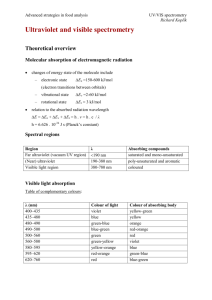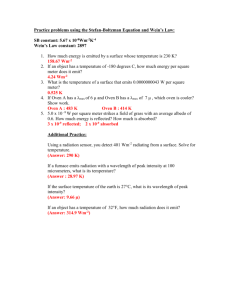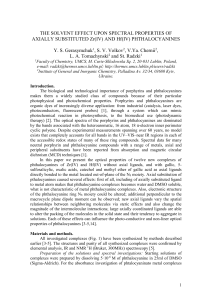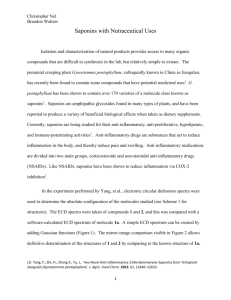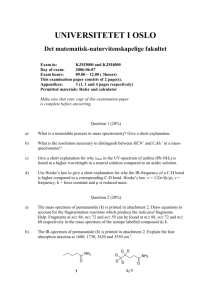UV-Vis Lesson 3 - Woodward
advertisement
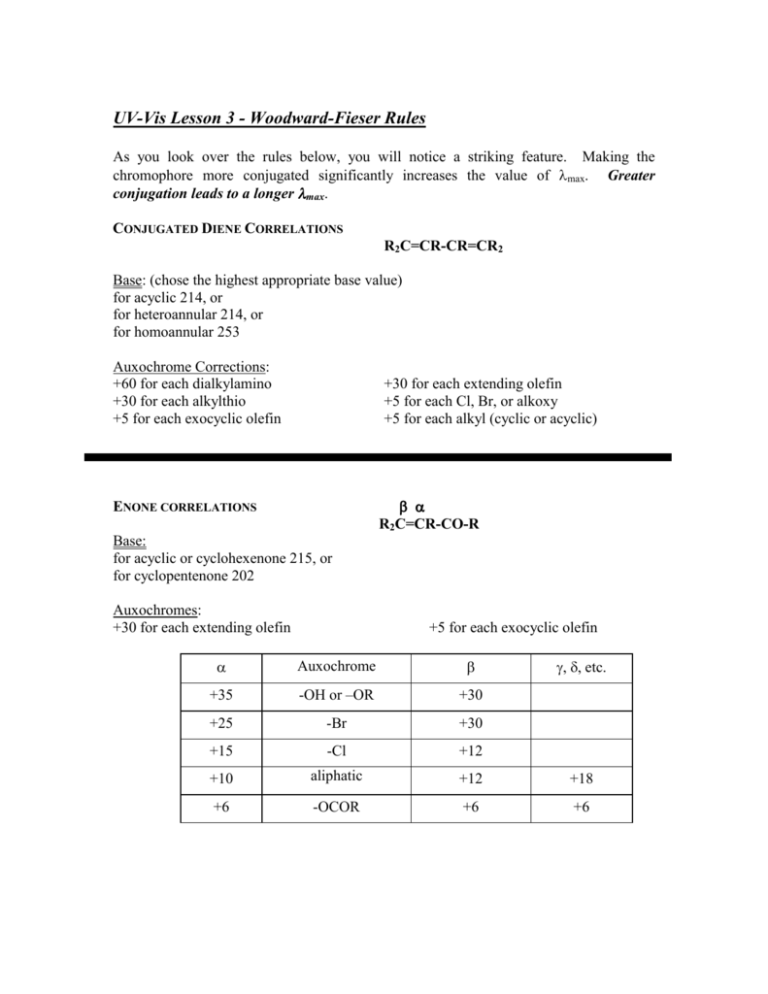
UV-Vis Lesson 3 - Woodward-Fieser Rules As you look over the rules below, you will notice a striking feature. Making the chromophore more conjugated significantly increases the value of λmax. Greater conjugation leads to a longer λmax. CONJUGATED DIENE CORRELATIONS R2C=CR-CR=CR2 Base: (chose the highest appropriate base value) for acyclic 214, or for heteroannular 214, or for homoannular 253 Auxochrome Corrections: +60 for each dialkylamino +30 for each alkylthio +5 for each exocyclic olefin +30 for each extending olefin +5 for each Cl, Br, or alkoxy +5 for each alkyl (cyclic or acyclic) β α R2C=CR-CO-R ENONE CORRELATIONS Base: for acyclic or cyclohexenone 215, or for cyclopentenone 202 Auxochromes: +30 for each extending olefin +5 for each exocyclic olefin γ, δ, etc. α Auxochrome β +35 -OH or –OR +30 +25 -Br +30 +15 -Cl +12 +10 aliphatic +12 +18 +6 -OCOR +6 +6 BENZOYL CORRELATIONS X-C6H4-CO-Z Base: where Z = H, 250; or where Z = aliphatic, 246; or where Z = O-H / O-R, 230 X-C6H4-COH (benzaldehydes) X-C6H4-COR (acetophenones, α-tetralones, etc.) X-C6H4-COOH / X-C6H4-COOR (acids / esters) Auxochromes: R o-, m- p- NR2 O-H, O-R aliphatic Br Cl 20 7 3 2 0 85 25 10 15 10 The rules listed above apply only to diene, enone or benzoyl containing compounds. If a compound does not contain one of these three chromophores, you will not be able to predict or calculate a diagnostic λmax value using these tables. Also, if a compound contains one of the listed chromophores, but it has an auxochrome that is not listed, then, the best that you will be able to do is to predict a minimum value for the diagnostic λmax. In these cases, the diagnostic λmax will be greater than the predicted λmax using the tables. In the event that you have a compound that fits the rules, the calculated λmax should be within (+/-) 3 nm of the λmax observed in the UV-Vis spectrum. Work through each of the examples listed in the following application notes to see how the rules are applied. As you work through them double-check the identification of chromophores, auxochromes, and special corrections (homoannular, heteroannular, exocyclic, etc.) that are applied to each case. You should NOT memorize the data tables. Application Examples for Woodward’s Rules Diene Example #1: 2 6 4 3 1 5 Calc. λmax = 214 (acyclic base) + 5 (alkyl auxochrome at C3) + 5 (alkyl auxochrome at C4) = 224 nm One way to identify an auxochrome is to draw a loop around the entire conjugated system (including extending olefins) and then add hash marks across all bonds attached to the loop. The hash marks define auxochrome attachments. 2 1 6 4 5 3 Diene Example #2: C B A C2 C1 Calc. λmax = C4 C3 214 (heteroannular since two pi bonds are not in the same ring) + 20 (5 + 5 + 5 + 5 = 20, for each of the alkyl or ring auxochromes attached to C1, C2, C4, and C4) + 5 (pi bond of C1-C2 is exocyclic to ring B) = 239 nm C B A C2 C1 C4 C3 Diene Example #3: C 1 A 2 B 3 5 6 Calc. λmax = 4 253 (choose diene with highest base value, pi bonds C1-2 and C3-4 are within same ring, so homoannular base should be selected) + 30 (C5-6 pi bond is conjugated to diene and is therefore an extending diene) + 5 (C5-6 is exocyclic to ring B) + 30 (5 + 5 + 5 + 5 + 5 + 5 = 30, for the alkyl or ring auxochromes at C1, C1, C2, C3, C5, and C6) = 318 nm Enone Example #1: C B A O Calc. λmax = α β γ δ 215 (cyclohexenone base) + 30 (extending conjugation) + 5 (α,β olefin is exocyclic to ring B) + 12 (β auxochrome) + 36 (2 δ auxochromes) = 298 nm O Benzoyl Example #1: O o o m m p Calc. λmax = 246 (Benzoyl Base, where Z is the aliphatic methyl group) + 3 (o auxochrome) + 3 (m auxochrome) = 252 nm O o o m m p Benzoyl Example # 2: O– O N+ O OCH3 Calc. λmax = 230 (Benzoyl Base, where Z is O-R in this ester functionality) + ? (There is no value listed for a meta nitro group.) > 230 nm. The rules are not perfect. They do not allow you to make predictions for all compounds, not even all the simple ones. The best you can predict in this situation is that the observed λmax should be greater than 230 nm. After all, the nitro group contains a π bond that extends the length of the conjugated π system. And if nothing else, you know that greater conjugation means longer wavelength λmax. O– O N+ O OCH3 QUVVis3-1. What is the predicted λmax for the compound drawn below? QUVVis3-2. Calculate the predicted λmax for the compound drawn below. O AUVVis3-1. 298 nm 298 = 253 (homoannular base) + 30 (extending olefin) + 15 (three alkyl auxochromes on alkene π system) QUVVis3-3. What is the chromophore in the O compound drawn below? AUVVis3-2. 262 nm. 262 = 202 (cyclopentenone base) + 30 (extending olefin) + 12 (β alkyl auxochrome) + 18 (γ alkyl auxochrome) QUVVis3-4. What is the predicted λmax for the compound drawn in QUVVis3-3? AUVVIS3-3. Benzoyl. QUVVis3-5. What is the predicted λmax for the compound drawn below? O AUVVIS3-4. 249 nm. 246 (Z = aliphatic base) + 3 (ortho alkyl). O CH3 Cl QUVVis3-6. Suppose you have the two compounds listed below and a UV-Vis instrument, but no access to tables or rules for calculation of λmax values. How could you use UV-Vis to differentiate between these two compounds? O O A AUVVis3-5. 249 nm. 246 (benzoyl base, where the aliphatic carbon atom of the group -CH2OCH3, not the oxygen atom, is directly attached to the benzoyl carbonyl so that Z = aliphatic) + 0 (meta Cl) + 3 (meta alkyl). You could NOT use predicted λmax values to differentiate between the compounds drawn in problems QUVVIS3-4 and QUVVIS3-5! B AUVVis3-6 Record λmax of both compounds. The compound with the longer wavelength (>nm) will be the more conjugated isomer (B).
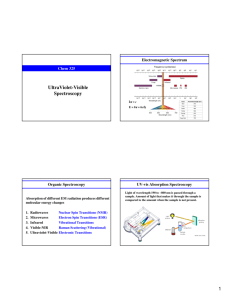
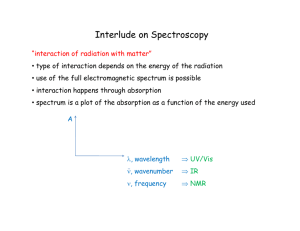
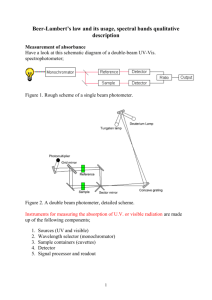
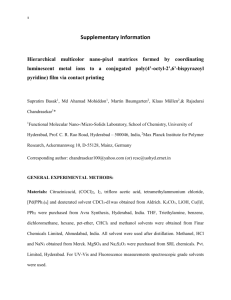
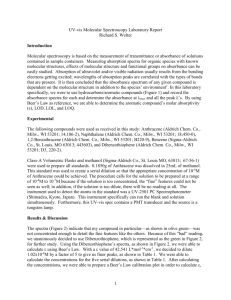
![Spectrophotometry[1]](http://s3.studylib.net/store/data/007454827_1-dfdf27b15995064ef8777d6c3b5bf478-300x300.png)
